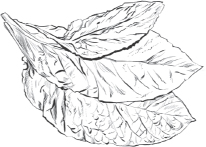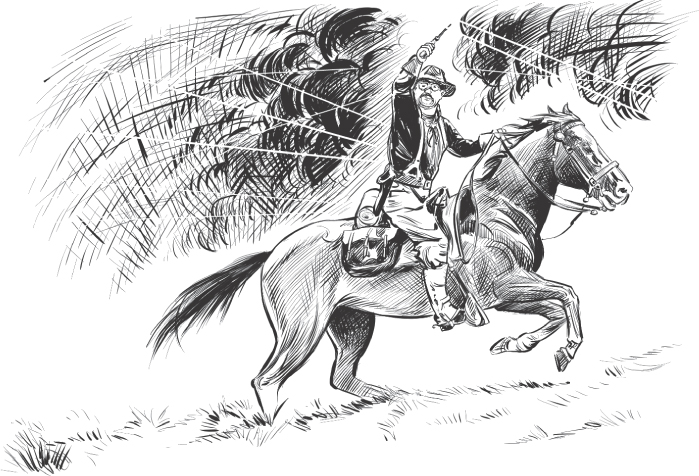
In Washington, Roosevelt was eager to make the United States Navy one of the strongest in the world. The country was increasingly exporting goods such as wheat, machinery, and oil to distant lands, like Japan and China. Americans competed with Europeans to buy and sell some of the same items to foreign countries. The European nations owned colonies around the world, and Roosevelt thought the United States should own colonies, too. But having overseas trade and colonies required a navy to defend American businesses. And, if necessary, the country had to be ready to go to war. Roosevelt wanted to build a navy able to win battles anywhere in the world.



One place that concerned Roosevelt was Cuba. In 1897, it was a colony of Spain. Many Cubans, however, wanted their independence, and for several years they had battled the Spanish for their freedom. Americans paid attention to Cuba because it was so close to Florida and because its farms produced two very valuable crops: sugar and tobacco. Roosevelt wanted the US to help Cubans win independence from Spain. Then the United States could play a larger role in the island’s economy.


As 1898 began, violence erupted in Cuba. A US battleship, the Maine, soon arrived at the island to protect Americans who lived there. In February, the Maine mysteriously blew up. Some Americans blamed Spain. (Historians now know the explosion was an accident.) Roosevelt quickly joined the call for war against the Spanish. He also ordered US naval ships to sail from China to the Philippines, another Spanish colony.

In April, the United States officially declared war against Spain. Theodore Roosevelt wanted to be part of the action. He didn’t want to spend the war in an office in Washington. He also knew that success in battle had boosted the political careers of many men before him. Even though he and Edith had just had their fifth and last child, Quentin, Roosevelt made a bold decision. A few months before his fortieth birthday, he quit his job in the Navy Department and volunteered to fight.
Thanks to his adventures in the Badlands, Roosevelt was an excellent shooter and rode horses well. He was given the title of lieutenant colonel and assigned to a cavalry unit. Although technically not the unit commander, Roosevelt played a major role in finding volunteers. The group came to be called the Rough Riders. At the end of May 1898, about one thousand Rough Riders left their training ground in Texas for Florida, where they waited for orders to sail to Cuba.

When the Rough Riders finally sailed for Cuba, there was room for only 560 of them. Only officers were allowed to bring their horses. Despite the space limits, Roosevelt managed to get two news photographers on board the ship. He wanted to make sure they showed Americans the bravery of his men on the battlefield. He also packed a dozen extra pairs of glasses, in case any were lost or broken. On June 22, the Rough Riders came ashore in Cuba. They were part of a larger US force of about seventeen thousand troops.
For Roosevelt and his men, the deadliest action came on July 1. The Rough Riders were sent to help capture the town of El Caney. Their first target was a building the Spanish held on what the Americans called Kettle Hill. As the battle started, Spanish bullets rained down on the Rough Riders from other hills behind it. Roosevelt rode a horse named Little Texas as his men marched in heat that soared to one hundred degrees.

At the foot of the hill, Roosevelt ordered aside other troops so his Rough Riders could go forward. He then led the charge, with a bullet brushing by his arm. As the Americans went farther up, Roosevelt got off his horse and led his men on foot. Soon the Americans controlled Kettle Hill. From there, the Americans fired on Spanish troops at nearby San Juan Hill. Roosevelt then led a second charge up San Juan Hill, and once again the Spaniards fled.

WHEN WORD WENT OUT THAT THEODORE ROOSEVELT WAS GOING TO LEAD A CAVALRY UNIT, ABOUT TWENTY-THREE THOUSAND MEN FROM ALL OVER THE COUNTRY VOLUNTEERED TO JOIN HIM. SOME, LIKE ROOSEVELT, CAME FROM WEALTHY FAMILIES IN THE EAST AND HAD GONE TO FINE COLLEGES. OTHERS WERE COWBOYS FROM NEW MEXICO, TEXAS, AND OTHER PARTS OF THE WEST. SOME WERE NATIVE AMERICANS. A FEW OF THE MEN WHO DIDN’T KNOW ROOSEVELT WERE SURPRISED TO SEE HE WORE GLASSES. “SPECTACLES,” AS THEY WERE CALLED, WERE NOT CONSIDERED MANLY IN THE WEST. TO ROOSEVELT, THE ROUGH RIDERS WERE “AS FINE NATURAL FIGHTING MEN AS EVER CARRIED A RIFLE OR RODE A HORSE.”

The war in Cuba lasted several more weeks before the Americans finally won and Cuba was free from Spanish rule. Roosevelt returned to New York in August and found himself a national hero for his bravery in Cuba. The following month he became the Republican candidate for governor of New York. He won the election easily. Now, at just forty years old, he led the most populous state in the country. Some people referred to him as the “boy governor.”

For two years, Governor Roosevelt sometimes battled lawmakers to get the laws he wanted for the state approved. These included a new tax on certain businesses and shorter working hours for women and children. (Children often worked in coal mines and factories at this time.) He became known for the phrase “Speak softly and carry a big stick, and you will go far.” Roosevelt meant that you have to back up words with actions. He felt that respect was earned only through hard work and determination. And Roosevelt was thinking about going far. He still hoped to one day be president of the United States.
